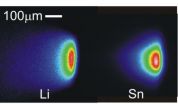(Press-News.org) Washington, DC — Monkeys moved thought-controlled computer cursors more quickly and accurately when provided with additional sensory feedback, according to a new study in the Dec. 15 issue of The Journal of Neuroscience. While most brain-machine technologies rely only on visual feedback, this study demonstrated that these systems can be improved when users have additional input, such as a sense of the arm's position and motion, a sensation known as proprioception.
With the aid of brain-controlled devices, paralyzed people have been able to send e-mail, play video games, and operate robotic arms. In this study, researchers led by Nicholas Hatsopoulos, PhD, of the University of Chicago, aimed to help further develop such machines for people who may still experience feeling in paralyzed limbs, including many patients with spinal cord injury and amyotrophic lateral sclerosis (ALS).
"Organisms use multiple senses, including sight and touch, as feedback to adjust motor behavior," Hatsopoulos said. "The ability to feel movements of the limbs and body is critical for normal motor control. Loss of this sense results in movements that are slow, poorly coordinated, and require great concentration."
The authors worked with two adult rhesus macaques to assess a system that incorporates a sense of movement. Each monkey was first trained to control a cursor using brain signals only; electrodes collected and processed data from the monkeys' motor cortex cells and transmitted those commands to the computer. Basic science research has shown that simply thinking about a motion activates brain cells in the same way that making the movement does, so each monkey needed to only think about moving a cursor to do it.
The researchers equipped each animal with a robotic "sleeve" that fit over an arm. In the first part of the experiment, the monkeys controlled the cursor by simply looking at the computer screen. In the second part, the robotic device moved the monkey's relaxed arm in tandem with the cursor movement, so the monkey could sense the cursor's motion in time and space. The authors found when the monkeys had the extra sensation, the cursor hit the target faster and more directly. The results also showed increased movement-related information in the activity of motor cortex cells, compared with visual-only feedback.
Hatsopoulos said his group's findings may pave the way for enhanced brain-controlled devices that include multiple forms of natural or even artificially produced sensory feedback. "Wearable exoskeletal robots could provide sensory information to patients with full or partial feeling," he said. "Alternatively, direct stimulation of the relevant area of the cortex could be used to replicate sensory feedback in patients who have lost both motor and sensory function."
INFORMATION:
The research was supported by the National Institute of Neurological Disorders and Stroke and the Paralyzed Veterans of America Research Foundation.
The Journal of Neuroscience is published by the Society for Neuroscience, an organization of more than 40,000 basic scientists and clinicians who study the brain and nervous system. Hatsopoulos can be reached at nicho@uchicago.edu.
Enhanced brain-machine interface taps into additional senses
Study shows sensory feedback gives monkeys better control of computer cursors
2010-12-15
ELSE PRESS RELEASES FROM THIS DATE:
Champion hydrogen-producing microbe
2010-12-15
Inside a small cabinet the size of a dorm refrigerator in one of Himadri B. Pakrasi's labs, a blue-green soup percolates in thick glass bottles under the cool light of red, blue and green LEDS.
This isn't just any soup, however. It is a soup of champions.
The soup is colored by a strain of blue-green bacteria that bubble off roughly 10 times the hydrogen gas produced by their nearest competitors—in part because of their unique genetic endowment but also in part because of tricks the scientists have played on their metabolism.
Hydrogen gas can be produced by microbes ...
Gene information predicts survival time, possible new treatment options for lung-cancer patients
2010-12-15
DALLAS – Dec. 14, 2010 – Researchers at UT Southwestern Medical Center have discovered sets of genes active in cancer cells and normal tissue that predict survival time and potential new treatments for patients with non-small cell lung cancer.
"Patient responses to cancer treatment vary widely and often depend on subtle biological differences among tumors," said Dr. David Mangelsdorf, chairman of pharmacology at UT Southwestern and co-lead author of the study, published Dec. 14 by PLoS Medicine.
"These findings are important because the ability to determine which genes ...
The key to being attractive (and looking healthy)? A good night's sleep
2010-12-15
If you want to look attractive and healthy, the best thing you can do is get a good night's sleep, finds research in the Christmas issue published on bmj.com today.
For the first time, say the authors, there is scientific backing for the concept of beauty sleep.
The study, led by John Axelsson from the Karolinska Institutet in Sweden, investigated the relationship between sleep and perceptions of attractiveness and health. The authors believe this research is important in today's 24 hour society with the number of people suffering from sleep disorders and disturbed ...
Drinking alcohol during a rich meal slows down digestion, but doesn't increase indigestion
2010-12-15
People can be reassured that while alcohol may slow down digestion after a rich calorific meal, enjoyed by many during the Christmas season, it will not cause indigestion symptoms such as heartburn, belching and bloating, finds research in the Christmas issue published on bmj.com today.
In order to determine the effects of alcohol on the digestive system when rich meals are consumed, investigators at the University Hospital of Zurich, led by Dr Mark Fox now at the Queens Medical Centre in Nottingham, studied 20 individuals who either drank wine or black tea with cheese ...
Submerging your feet in alcohol will not get you drunk
2010-12-15
Research in the Christmas issue published on bmj.com today explodes the Danish myth that it is possible to get drunk by submerging your feet in alcohol.
The authors, led by Dr Peter Lommer Kristensen from the Hillerød Hospital in Denmark, say it was important that the myth underwent scientific scrutiny to prevent students wasting their time experimenting with this activity.
Three adult volunteers took part in the study. None of them suffered from any chronic skin or liver disease and they were not addicted to alcohol or psychoactive drugs. The participants were not ...
Sovereign's head identified after more than 4 centuries
2010-12-15
The skeletons of kings and queens lying in mass graves in the Royal Basilica of Saint-Denis in Paris could finally have the solemn funeral ceremonies they deserve, say experts in the Christmas issue published on bmj.com today.
Many of the graves in the Royal Basilica were destroyed by revolutionaries in 1793 and very few remains of the mummified bodies have been preserved and identified.
Dr Philippe Charlier led the scientific breakthrough that has identified the head of the French King, Henri IV.
A team of scientists from different fields of expertise including ...
Iridium memories
2010-12-15
Washington, D.C. (December 14, 2010) -- One of the rarest metals on Earth may be an excellent option for enabling future flash memory chips to continue to increase in speed and density, according to a group of researchers in Taiwan.
"Incorporating nanocrystals of iridium into the critical floating gate portion of flash memory designs shows both excellent memory properties as well as stability in the high temperatures used in processing such semiconductor devices," says the research team leader, Wen-Shou Tseng of Taiwan's Center for Measurement Standards, Industrial Technology ...
Making wafers faster by making features smaller
2010-12-15
Washington, D.C. (December 14, 2010) -- The manufacturing of semiconductor wafers used in all types of electronics involves etching small features onto a wafer with lasers, a process that is ultimately limited by the wavelength of the light itself. The semiconductor industry is rapidly approaching this fundamental limit for increasing the speed of the microchip. The development of a new intense 13.5-nm (extreme ultraviolet or EUV) light source will resolve this issue by reducing the feature size by an order of magnitude or so, according to Purdue researchers in the Journal ...
Single quantum dot nanowire photodetectors
2010-12-15
Washington, D.C. (December 14, 2010) -- Moving a step closer toward quantum computing, a research team in the Netherlands recently fabricated a photodetector based on a single nanowire, in which the active element is a single quantum dot with a volume of a mere 7,000 cubic nanometers. The device is described in the American Institute of Physics' journal Applied Physics Letters.
Photodetectors based on single quantum dots are expected to find uses in optoelectrical interfaces in future quantum computers, where single photons will carry information over long distances and ...
Robot arm improves performance of brain-controlled device
2010-12-15
The performance of a brain-machine interface designed to help paralyzed subjects move objects with their thoughts is improved with the addition of a robotic arm providing sensory feedback, a new study from the University of Chicago finds.
Devices that translate brain activity into the movement of a computer cursor or an external robotic arm have already proven successful in humans. But in these early systems, vision was the only tool a subject could use to help control the motion.
Adding a robot arm that provided kinesthetic information about movement and position ...
LAST 30 PRESS RELEASES:
Reducing social isolation protects the brain in later life
Keeping the heart healthy increases longevity even after cancer
Young adults commonly mix cannabis with nicotine and tobacco
Comprehensive review illuminates tau protein's dual nature in brain health, disease, and emerging psychiatric connections
Book prepares K-12 leaders for the next public health crisis
Storms in the Southern Ocean mitigates global warming
Seals on the move: Research reveals key data for offshore development and international ecology
Sports injuries sustained during your period might be more severe
World's first successful 2 Tbit/s free-space optical communication using small optical terminals mountable on satellites and HAPS
Can intimate relationships affect your heart? New study says ‘yes’
Scalable and healable gradient textiles for multi‑scenario radiative cooling via bicomponent blow spinning
Research shows informed traders never let a good climate crisis go to waste
Intelligent XGBoost framework enhances asphalt pavement skid resistance assessment
Dual-function biomaterials for postoperative osteosarcoma: Tumor suppression and bone regeneration
New framework reveals where transport emissions concentrate in Singapore
NTP-enhanced lattice oxygen activation in Ce-Co catalysts for low-temperature soot combustion
Synergistic interface engineering in Cu-Zn-Ce catalysts for efficient CO2 hydrogenation to methanol
COVID-19 leaves a lasting mark on the human brain
Scientists use ultrasound to soften and treat cancer tumors without damaging healthy tissue
Community swimming program for Black youth boosts skills, sense of belonging, study finds
Specific depressive symptoms in midlife linked to increased dementia risk
An ‘illuminating’ design sheds light on cholesterol
Who is more likely to get long COVID?
Study showcases resilience and rapid growth of “living rocks”
Naval Research Lab diver earns Office of Naval Research 2025 Sailor of the Year
New Mayo-led study establishes practical definition for rapidly progressive dementia
Fossil fuel industry’s “climate false solutions” reinforce its power and aggravate environmental injustice
Researchers reveal bias in a widely used measure of algorithm performance
Alcohol causes cancer. A study from IOCB Prague confirms damage to DNA and shows how cells defend against it
Hidden viruses in wastewater treatment may shape public health risks, study finds
[Press-News.org] Enhanced brain-machine interface taps into additional sensesStudy shows sensory feedback gives monkeys better control of computer cursors



